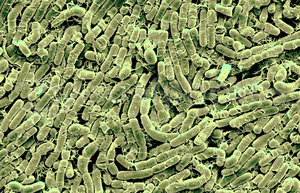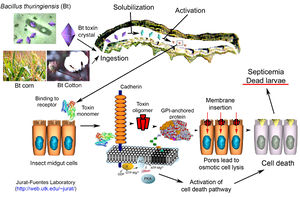Utilization of Bacillus thuringiensis in Genetically Modified Crops: Difference between revisions
No edit summary |
|||
| Line 58: | Line 58: | ||
==References== | ==References== | ||
[1] | [1] Aeschbacher, K., Messikommer, R., Meile, L. & Wenk, C. (2005). Bt176 Corn in Poultry Nutrition: Physiological Characteristics and Fate of Recombinant Plant DNA in Chickens. Poultry Science Association, 84, 385 – 394. | ||
[2] | [2] Catarino, R., G. Ceddia, F.J. Areal, and J. Park. (2015). The impact of secondary pests on Bacillus thuringiensis (Bt) crops. Plant Biotechnology Journal, 1-12. | ||
[3] Cheeke, T.E., U.M. Schütte, C.M. Hemmerich, M.B. Cruzan, T.N. Rosenstiel, and J.D. Bever. (2015). Spatial soil heterogeneity has a greater effect on symbiotic aburscular mycorrhizal fungal communities and plant growth than genetic modification with Bacillus thuringiensis toxin genes. Molecular Ecology, 1-33. | |||
[4] Cranshaw, W.S. Bacillus thuringiensis: Fact Sheet No. 5.556. Insect Series, Home and Garden. Colorado State Univserity. | |||
[5] de Maagd, R.A. 2015. Chapter 20: Bacillus thuringiensis- Based Products for Insect Pest Control. Principles of Plant-Microbe Interactions. Springer International Switzerland, 2015. 185-192. | |||
[6] Finucane, M.L. & J.L. Holup. (2005). Psychosocial and cultural factors affecting the perceived risk of genetically modified food: an overview of the literature. Social Science & Medicine, 60, 1603 – 1612. | |||
[7] Gassmann, A.J. J.L., Petzold-Maxwell, E.H. Clifton, M.W. Dunbar, A.M. Hoffmann, D.A. Ingber, and R.S. Keweshan. (2014). Field-evolved resistance by western corn rootworm to multiple Bacillus thuringiensis toxins in transgenic maize. PNAS, 111(14), 5141-5146. | |||
[8]Hansen Jesse, L.C. & J.J. Obrlycki. (2000). Field deposition of Bt transgenic corn pollen: lethal effects on the monarch butterfly. Oecologia, 125, 241 – 248. | |||
[9] Ibrahim, M.A., N. Griko, M. Junker, and L.A. Bulla. 2010. Bacillus thuringiensis: A genomic and proteomics perspective. Bioengineered Bugs 1:1, 31-50. | |||
[10] Jurat-Fuentes, J.L. "What Is Bacillus Thuringiensis (Bt)?" Bt Mode of Action. The University of Tennessee Institute of Agriculture. Web. <http://web.utk.edu/~jurat/Btresearchtable.html>. | |||
[11] Petras, S.F. and L.E. Casida. (1985). Survival of Bacillus thuringiensis Spores in Soil. Applied and Environmental Microbiology, 59, 1496 – 1501. | |||
[12] Uzogara, S.G. (2000). The impact of genetic modification of human foods in the 21st century: A review. Biotechnology Advances, 18, 179 – 206. | |||
Revision as of 22:37, 20 April 2015
Introduction

By Zoë Frazier
At right is a sample image insertion. It works for any image uploaded anywhere to MicrobeWiki. The insertion code consists of:
Double brackets: [[
Filename: PHIL_1181_lores.jpg
Thumbnail status: |thumb|
Pixel size: |300px|
Placement on page: |right|
Legend/credit: Electron micrograph of the Ebola Zaire virus. This was the first photo ever taken of the virus, on 10/13/1976. By Dr. F.A. Murphy, now at U.C. Davis, then at the CDC.
Closed double brackets: ]]
Other examples:
Bold
Italic
Subscript: H2O
Superscript: Fe3+
Introduce the topic of your paper. What microorganisms are of interest? Habitat? Applications for medicine and/or environment?
Structure and Phylogeny
Include some current research, with at least one figure showing data.
History
Include some current research, with at least one figure showing data.
Life Cycle
Figure 2.
Bt Toxins

Figure 3.
Bt Crops

Figure 4.
Ethical Issues Surrounding Bt Crops
Include some current research, with at least one figure showing data.
Evolved Resistance and Secondary Pests

Figure 5.
Conclusion
Include conclusion
References
[1] Aeschbacher, K., Messikommer, R., Meile, L. & Wenk, C. (2005). Bt176 Corn in Poultry Nutrition: Physiological Characteristics and Fate of Recombinant Plant DNA in Chickens. Poultry Science Association, 84, 385 – 394.
[2] Catarino, R., G. Ceddia, F.J. Areal, and J. Park. (2015). The impact of secondary pests on Bacillus thuringiensis (Bt) crops. Plant Biotechnology Journal, 1-12.
[3] Cheeke, T.E., U.M. Schütte, C.M. Hemmerich, M.B. Cruzan, T.N. Rosenstiel, and J.D. Bever. (2015). Spatial soil heterogeneity has a greater effect on symbiotic aburscular mycorrhizal fungal communities and plant growth than genetic modification with Bacillus thuringiensis toxin genes. Molecular Ecology, 1-33.
[4] Cranshaw, W.S. Bacillus thuringiensis: Fact Sheet No. 5.556. Insect Series, Home and Garden. Colorado State Univserity.
[5] de Maagd, R.A. 2015. Chapter 20: Bacillus thuringiensis- Based Products for Insect Pest Control. Principles of Plant-Microbe Interactions. Springer International Switzerland, 2015. 185-192.
[6] Finucane, M.L. & J.L. Holup. (2005). Psychosocial and cultural factors affecting the perceived risk of genetically modified food: an overview of the literature. Social Science & Medicine, 60, 1603 – 1612.
[7] Gassmann, A.J. J.L., Petzold-Maxwell, E.H. Clifton, M.W. Dunbar, A.M. Hoffmann, D.A. Ingber, and R.S. Keweshan. (2014). Field-evolved resistance by western corn rootworm to multiple Bacillus thuringiensis toxins in transgenic maize. PNAS, 111(14), 5141-5146.
[8]Hansen Jesse, L.C. & J.J. Obrlycki. (2000). Field deposition of Bt transgenic corn pollen: lethal effects on the monarch butterfly. Oecologia, 125, 241 – 248.
[9] Ibrahim, M.A., N. Griko, M. Junker, and L.A. Bulla. 2010. Bacillus thuringiensis: A genomic and proteomics perspective. Bioengineered Bugs 1:1, 31-50.
[10] Jurat-Fuentes, J.L. "What Is Bacillus Thuringiensis (Bt)?" Bt Mode of Action. The University of Tennessee Institute of Agriculture. Web. <http://web.utk.edu/~jurat/Btresearchtable.html>.
[11] Petras, S.F. and L.E. Casida. (1985). Survival of Bacillus thuringiensis Spores in Soil. Applied and Environmental Microbiology, 59, 1496 – 1501.
[12] Uzogara, S.G. (2000). The impact of genetic modification of human foods in the 21st century: A review. Biotechnology Advances, 18, 179 – 206.

